INTRODUCTION OF COMPUTER NETWORK PROGRAM
Complete This Course Give Test And Get official Certificate
By The Brain Booster
🌐 Module 1🌐
A computer network is a group of devices connected with each other through a transmission medium such as wires, cables etc. These devices can be computers, printers, scanners, Fax machines etc.
The purpose of having computer network is to send and receive data stored in other devices over the network. These devices are often referred as nodes.
There are five basic components of a computer network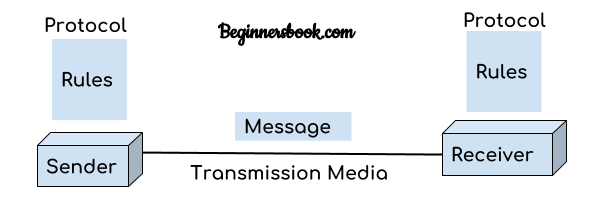
Message: It is the data or information which needs to be transferred from one device to another device over a computer network.
Sender: Sender is the device that has the data and needs to send the data to other device connected to the network.
Receiver: A receiver is the device which is expecting the data from other device on the network.
Transmission media: In order to transfer data from one device to another device we need a transmission media such as wires, cables, radio waves etc.
Protocol: A protocol is a set of rules that are agreed by both sender and receiver, without a protocol two devices can be connected to each other but they cannot communicate. In order to establish a reliable communication or data sharing between two different devices we need set of rules that are called protocol. For example, http and https are the two protocols used by web browsers to get and post the data to internet, similarly smtp protocol is used by email services connected to the internet.
A computer network has following features:
Performance: Performance of a computer network is measured in terms of response time. The response time of sending and receiving data from one node (computer in a computer network are often referred as node) to another should be minimal.
Data Sharing: One of the reason why we use a computer network is to share the data between different systems connected with each other through a transmission media.
Backup: A computer network must have a central server that keeps the backup of all the data that is to be shared over a network so that in case of a failure it should be able to recover the data faster.
Software and hardware compatibility: A computer network must not limit all the computers in a computer network to use same software and hardware, instead it should allow the better compatibility between the different software and hardware configuration.
Reliability: There should not be any failure in the network or if it occurs the recovery from a failure should be fast.
Security: A computer network should be secure so that the data transmitting over a network should be safe from unauthorised access. Also, the sent data should be received as it is at the receiving node, which means there should not be any loss of data during transmission.
Scalability: A computer network should be scalable which means it should always allow to add new computers (or nodes) to the already existing computer network. For example, a company runs 100 computers over a computer network for their 100 employees, lets say they hire another 100 employees and want to add new 100 computers to the already existing LAN then in that case the local area computer network should allow this.
👇Certification And Test Link Below👇
🌐Module 2🌐
Computer Network Architecture
A Computer Architecture is a design in which all computers in a computer network are organized. A architecture defines how the computers should get connected to get the maximum advantages of a computer network such as better response time, security, scalability etc. The two most popular computer architectures are P2P (Peer to Peer) and Client-Server architecture.
Peer to Peer Architecture
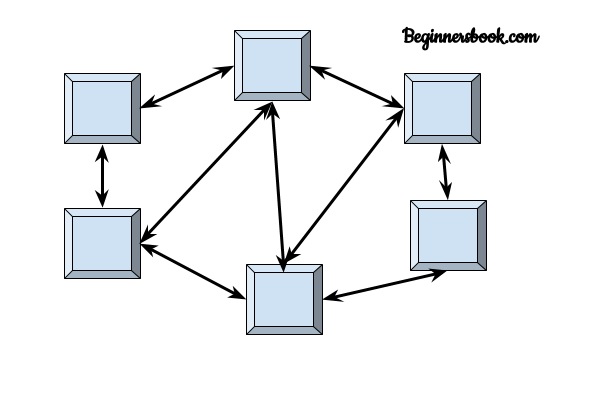
In peer to peer architecture all the computers in a computer network are connected with every computer in the network. Every computer in the network use the same resources as other computers. There is no central computer that acts as a server rather all computers acts as a server for the data that is stored in them.
Advantages of a Peer to Peer Architecture
1. Less costly as there is no central server that has to take the backup.
2. In case of a computer failure all other computers in the network are not affected and they will continue to work as same as before the failure.
3. Installation of peer to peer architecture is quite easy as each computer manages itself.
Disadvantages of a Peer to Peer Architecture
1. Each computer has to take the backup rather than a central computer and the security measures are to be taken by all the computers separately.
2. Scalability is a issue in a peer to Peer Architecture as connecting each computer to every computer is a headache on a very large network.
👇Certification And Test Link Below👇
Client Server Architecture
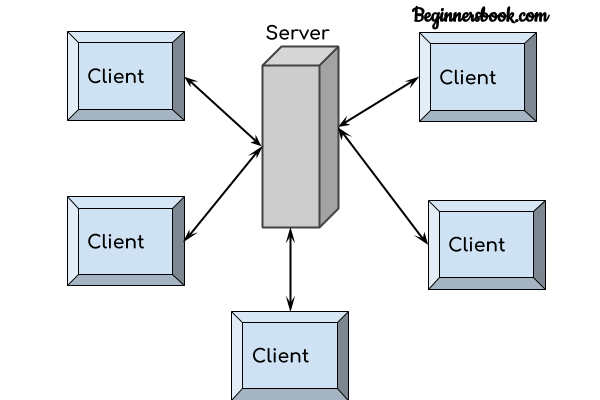
In Client Server architecture a central computer acts as a hub and serves all the requests from client computers. All the shared data is stored in the server computer which is shared with the client computer when a request is made by the client computer.
All the communication takes place through the server computer, for example if a client computer wants to share the data with other client computer then it has to send the data to server first and then the server will send the data to other client.
Advantages of Client Server Architecture
1. Data backup is easy and cost effective as there is no need to manage the backup on each computer.
2. Performance is better as the response time is greatly improves because the server is more powerful computer than the other computers in the network.
3. Security is better as unauthorised access are denied by server computer and all the data goes through the server.
4. Scalability is not an issue in this Architecture as large number of computers can be connected with server.
Disadvantages of Client Server Architecture
1. In case of server failure entire network is down.
2. Server maintenance cost is high as the server is the main component in this Architecture
3. Cost is high as the server needs more resources to handle that many client requests and to be able to hold large amount of data
🌐Module 3🌐
Computer Network Components
A computer network is build up from several components. These components together makes it possible to transfer data from one device to another and makes smooth communication between two different devices. In this guide, we will discuss the main components of a computer network.
Basic components of a computer network
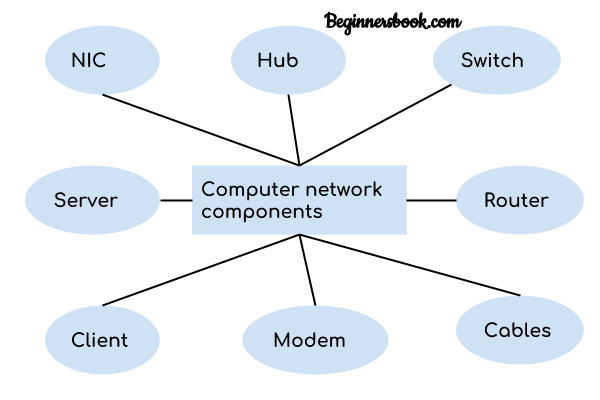
Server: Servers are computers that runs operating system and hold data that can be shared over a computer network.
Client: A client is a computer that is connected to other computers in the network and can receive data sent by other computers.
Transmission Media: All computers in a computer network are connected with each other through a transmission media such as wires, optical fibre cables, coaxial cables etc.
Network Interface card: Each system or computer in a computer network must have a card called network interface card (NIC). The main purpose of NIC is to format the data, send the data and receive the data at the receiving node.
Hub: Hub acts as a device that connects all the computer in a network to each other. Any request that comes from a client computer first received by Hub and then hub transmit this request over a network so that the correct server receives and respond to it.
Switch: Switch is similar to hub however instead of broadcasting a incoming data request it uses the physical device address in the incoming request to transfer the request to correct server computer.
Router: Router joins multiple computer networks to each other. For example lets say a company runs 100 computers over a local area network(LAN) and another company runs another LAN of 150 computers. These both LANs can be connected with each other through a internet connection which is provided by the router.
LAN cable: A wire that is used to connect more than one computers or other devices such as printers and scanner to each other.
👇Certification And Test Link Below👇
🌐Module 4🌐
Computer Network Topology – Mesh, Star, Bus, Ring and Hybrid
Geometric representation of how the computers are connected to each other is known as topology. There are five types of topology – Mesh, Star, Bus, Ring and Hybrid.
Types of Topology
There are five types of topology in computer networks: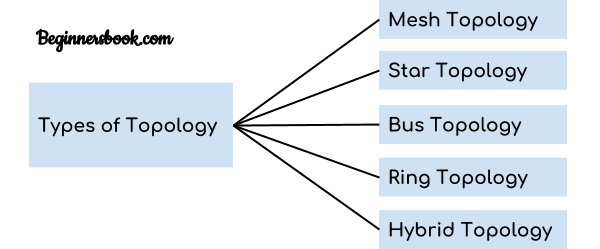
1. Mesh Topology
2. Star Topology
3. Bus Topology
4. Ring Topology
5. Hybrid Topology
Mesh Topology
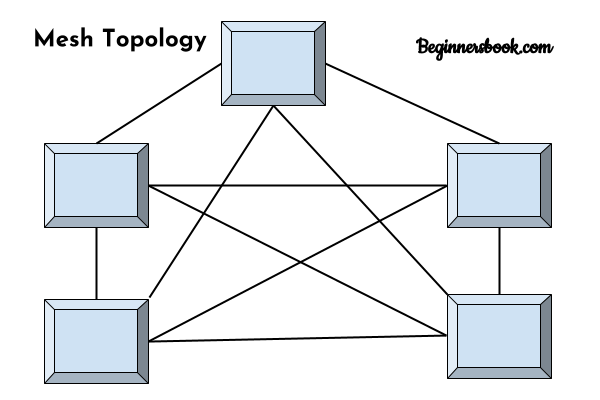
In mesh topology each device is connected to every other device on the network through a dedicated point-to-point link. When we say dedicated it means that the link only carries data for the two connected devices only. Lets say we have n devices in the network then each device must be connected with (n-1) devices of the network. Number of links in a mesh topology of n devices would be n(n-1)/2.
Advantages of Mesh topology
1. No data traffic issues as there is a dedicated link between two devices which means the link is only available for those two devices.
2. Mesh topology is reliable and robust as failure of one link doesn’t affect other links and the communication between other devices on the network.
3. Mesh topology is secure because there is a point to point link thus unauthorized access is not possible.
4. Fault detection is easy.
Disadvantages of Mesh topology
1. Amount of wires required to connected each system is tedious and headache.
2. Since each device needs to be connected with other devices, number of I/O ports required must be huge.
3. Scalability issues because a device cannot be connected with large number of devices with a dedicated point to point link.
Star Topology
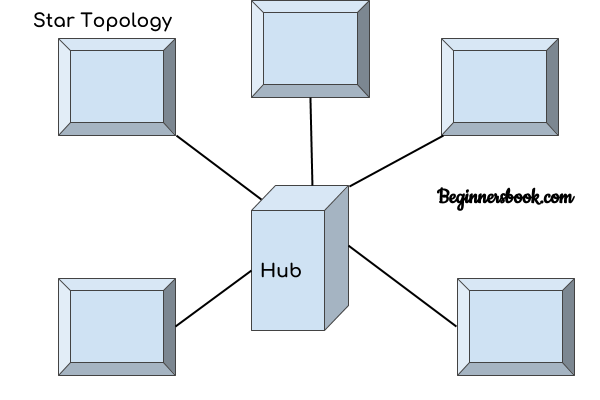
In star topology each device in the network is connected to a central device called hub. Unlike Mesh topology, star topology doesn’t allow direct communication between devices, a device must have to communicate through hub. If one device wants to send data to other device, it has to first send the data to hub and then the hub transmit that data to the designated device.
Advantages of Star topology
1. Less expensive because each device only need one I/O port and needs to be connected with hub with one link.
2. Easier to install
3. Less amount of cables required because each device needs to be connected with the hub only.
4. Robust, if one link fails, other links will work just fine.
5. Easy fault detection because the link can be easily identified.
Disadvantages of Star topology
1. If hub goes down everything goes down, none of the devices can work without hub.
2. Hub requires more resources and regular maintenance because it is the central system of star topology.
Bus Topology
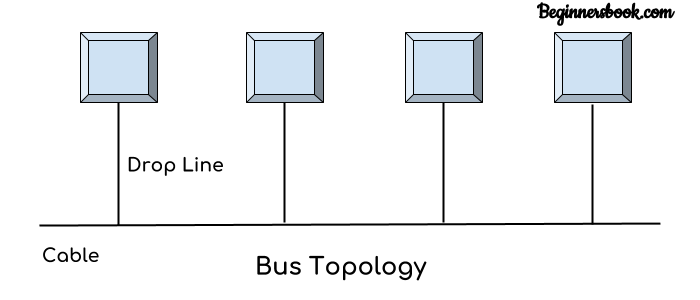
In bus topology there is a main cable and all the devices are connected to this main cable through drop lines. There is a device called tap that connects the drop line to the main cable. Since all the data is transmitted over the main cable, there is a limit of drop lines and the distance a main cable can have.
Advantages of bus topology
1. Easy installation, each cable needs to be connected with backbone cable.
2. Less cables required than Mesh and star topology
Disadvantages of bus topology
1. Difficultly in fault detection.
2. Not scalable as there is a limit of how many nodes you can connect with backbone cable.
Ring Topology
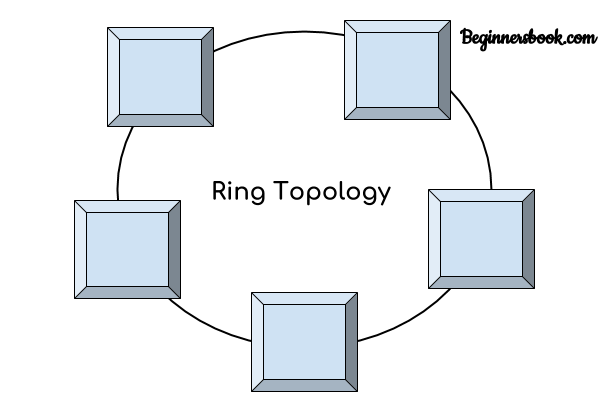
In ring topology each device is connected with the two devices on either side of it. There are two dedicated point to point links a device has with the devices on the either side of it. This structure forms a ring thus it is known as ring topology. If a device wants to send data to another device then it sends the data in one direction, each device in ring topology has a repeater, if the received data is intended for other device then repeater forwards this data until the intended device receives it.
Advantages of Ring Topology
1. Easy to install.
2. Managing is easier as to add or remove a device from the topology only two links are required to be changed.
Disadvantages of Ring Topology
1. A link failure can fail the entire network as the signal will not travel forward due to failure.
2. Data traffic issues, since all the data is circulating in a ring.
Hybrid topology
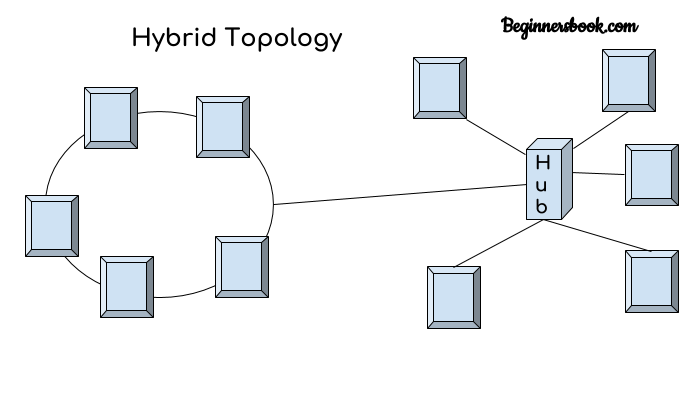
A combination of two or more topology is known as hybrid topology. For example a combination of star and mesh topology is known as hybrid topology.
Advantages of Hybrid topology
1. We can choose the topology based on the requirement for example, scalability is our concern then we can use star topology instead of bus technology.
2. Scalable as we can further connect other computer networks with the existing networks with different topologies.
Disadvantages of Hybrid topology
1. Fault detection is difficult.
2. Installation is difficult.
3. Design is complex so maintenance is high thus expensive.
👇Certification And Test Link Below👇
🌐Module 5🌐
Types of Computer Network: LAN, MAN and WAN
Types of Computer Network
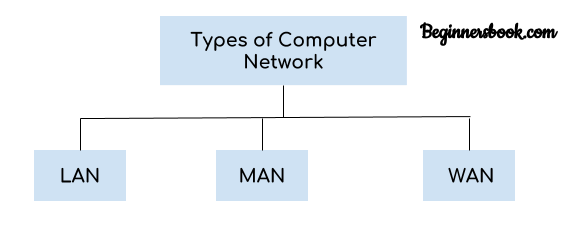
There are mainly three types of computer networks based on their size:
1. Local Area Network (LAN)
2. Metropolitan Area Network (MAN)
3. Wide area network (WAN)
1. Local Area Network (LAN)
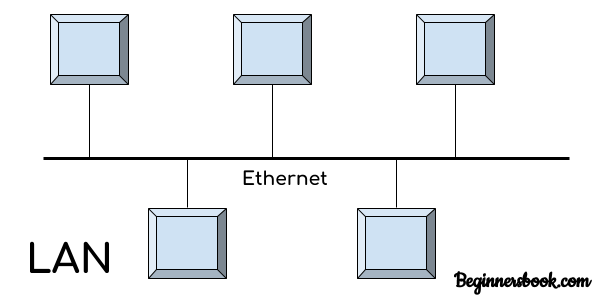
1. Local area network is a group of computers connected with each other in a small places such as school, hospital, apartment etc.
2. LAN is secure because there is no outside connection with the local area network thus the data which is shared is safe on the local area network and can’t be accessed outside.
3. LAN due to their small size are considerably faster, their speed can range anywhere from 100 to 100Mbps.
4. LANs are not limited to wire connection, there is a new evolution to the LANs that allows local area network to work on a wireless connection.
2. Metropolitan Area Network (MAN)
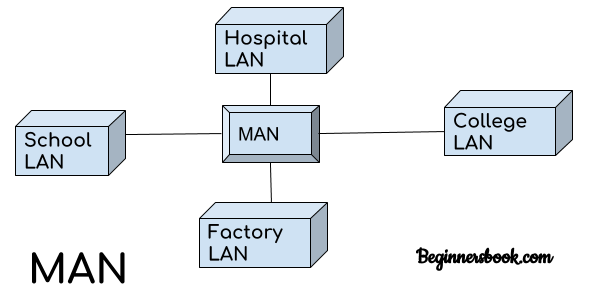
MAN network covers larger area by connections LANs to a larger network of computers. In Metropolitan area network various Local area networks are connected with each other through telephone lines. The size of the Metropolitan area network is larger than LANs and smaller than WANs(wide area networks), a MANs covers the larger area of a city or town.
3. Wide area network (WAN)
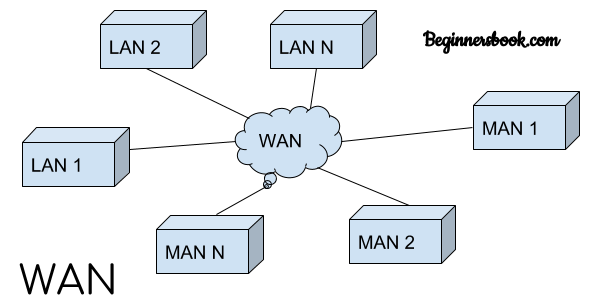
Wide area network provides long distance transmission of data. The size of the WAN is larger than LAN and MAN. A WAN can cover country, continent or even a whole world. Internet connection is an example of WAN. Other examples of WAN are mobile broadband connections such as 3G, 4G etc.
Advantages of WAN:
Centralized infrastructure: One of the main advantage of WAN is the that we do not need to maintain the backup and store data on local system as everything is stored online on a data centre, from where we can access the data through WAN.
Privacy: We can setup the WAN in such a way that it encrypts the data that we share online that way the data is secure and minimises the risk of unauthorized access.
Increased Bandwidth: With the WAN we get to choose the bandwidth based on the need, a large organization can have larger bandwidth that can carry large amount of data faster and efficiently.
Area: A WAN can cover a large area or even a whole world though internet connection thus we can connect with the person in another country through WAN which is not possible is other type of computer networks.
Disadvantages of WAN:
Antivirus: Since our systems are connected with the large amount of systems, there is possibility that we may unknowingly download the virus that can affect our system and become threat to our privacy and may lead to data loss.
Expensive: Cost of installation is very high.
Issue resolution: Issue resolution takes time as the WAN covers large area, it is really difficult to pin point the exact location where the issues raised and causing the problem.
Interconnection of Networks:
We have read LAN, MAN and WAN above, we also talked about internet. You can say that an internet is a combination of LAN, MAN and WAN.
👉Certification Link 👇
Give Test with 80% Passing Marks
Neso Academy For Video:-
https://www.youtube.com/channel/UCQYMhOMi_Cdj1CEAU-fv80A
Beginners Book For Notes:-


0 Comments